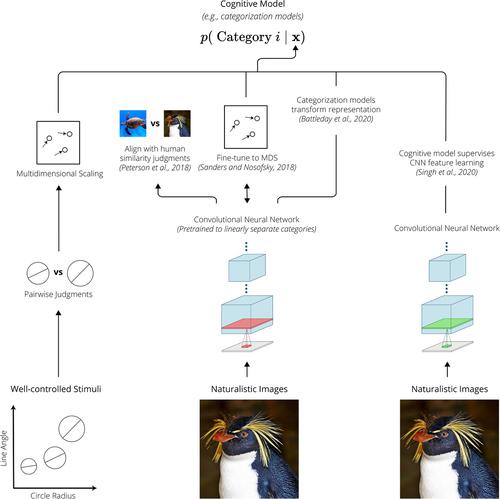当前位置:
X-MOL 学术
›
Ann. N. Y. Acad. Sci.
›
论文详情
Our official English website, www.x-mol.net, welcomes your
feedback! (Note: you will need to create a separate account there.)
From convolutional neural networks to models of higher-level cognition (and back again)
Annals of the New York Academy of Sciences ( IF 4.1 ) Pub Date : 2021-03-22 , DOI: 10.1111/nyas.14593 Ruairidh M Battleday 1 , Joshua C Peterson 1 , Thomas L Griffiths 1, 2
Annals of the New York Academy of Sciences ( IF 4.1 ) Pub Date : 2021-03-22 , DOI: 10.1111/nyas.14593 Ruairidh M Battleday 1 , Joshua C Peterson 1 , Thomas L Griffiths 1, 2
Affiliation

|
The remarkable successes of convolutional neural networks (CNNs) in modern computer vision are by now well known, and they are increasingly being explored as computational models of the human visual system. In this paper, we ask whether CNNs might also provide a basis for modeling higher-level cognition, focusing on the core phenomena of similarity and categorization. The most important advance comes from the ability of CNNs to learn high-dimensional representations of complex naturalistic images, substantially extending the scope of traditional cognitive models that were previously only evaluated with simple artificial stimuli. In all cases, the most successful combinations arise when CNN representations are used with cognitive models that have the capacity to transform them to better fit human behavior. One consequence of these insights is a toolkit for the integration of cognitively motivated constraints back into CNN training paradigms in computer vision and machine learning, and we review cases where this leads to improved performance. A second consequence is a roadmap for how CNNs and cognitive models can be more fully integrated in the future, allowing for flexible end-to-end algorithms that can learn representations from data while still retaining the structured behavior characteristic of human cognition.
中文翻译:

从卷积神经网络到高级认知模型(然后再回来)
卷积神经网络 (CNN) 在现代计算机视觉领域取得的显着成功现已众所周知,并且它们越来越多地被探索为人类视觉系统的计算模型。在本文中,我们询问 CNN 是否也可以为更高层次的认知建模提供基础,重点关注相似性和分类的核心现象。最重要的进步来自于 CNN 学习复杂自然图像的高维表示的能力,大大扩展了以前仅通过简单的人工刺激进行评估的传统认知模型的范围。在所有情况下,当 CNN 表示与能够将其转换为更好地适应人类行为的认知模型一起使用时,就会出现最成功的组合。这些见解的结果之一是提供了一个工具包,用于将认知驱动的约束集成回计算机视觉和机器学习中的 CNN 训练范式中,并且我们回顾了这导致性能提高的案例。第二个结果是未来如何更全面地集成 CNN 和认知模型的路线图,允许灵活的端到端算法,可以从数据中学习表示,同时仍然保留人类认知的结构化行为特征。
更新日期:2021-03-22
中文翻译:

从卷积神经网络到高级认知模型(然后再回来)
卷积神经网络 (CNN) 在现代计算机视觉领域取得的显着成功现已众所周知,并且它们越来越多地被探索为人类视觉系统的计算模型。在本文中,我们询问 CNN 是否也可以为更高层次的认知建模提供基础,重点关注相似性和分类的核心现象。最重要的进步来自于 CNN 学习复杂自然图像的高维表示的能力,大大扩展了以前仅通过简单的人工刺激进行评估的传统认知模型的范围。在所有情况下,当 CNN 表示与能够将其转换为更好地适应人类行为的认知模型一起使用时,就会出现最成功的组合。这些见解的结果之一是提供了一个工具包,用于将认知驱动的约束集成回计算机视觉和机器学习中的 CNN 训练范式中,并且我们回顾了这导致性能提高的案例。第二个结果是未来如何更全面地集成 CNN 和认知模型的路线图,允许灵活的端到端算法,可以从数据中学习表示,同时仍然保留人类认知的结构化行为特征。











































 京公网安备 11010802027423号
京公网安备 11010802027423号